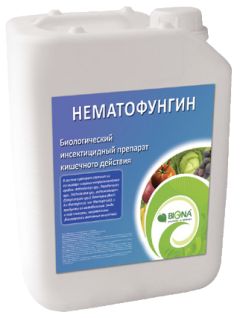| |||||
| |||||
Nematode
 Nematofungin is a composite preparation fighting root-not nematodes (Melodogyne spp.) and stem nematodes (Ditylenchus spp.), including in sheltered grounds (greenhouses and frames).
Nematofungin is a composite preparation fighting root-not nematodes (Melodogyne spp.) and stem nematodes (Ditylenchus spp.), including in sheltered grounds (greenhouses and frames).
The preparation comprises the following microorganisms
- carnivorous microscopic fungi (Arthrobotrys spp., Paecilomyces spp., Trichoderma spp.),
- an avermectin-producing actinomycete (Streptomyces spp.),
- and Bacillus thuringiensis.
Nematofungin is a suspension of (a) bacteria and (b) microcapsules harboring the fungi (this setup ensures increased activity of the preparation).
The fungi of the genera Arthrobotrys and Paecilomyces are capable of forming septate hyphae, which act as nematode-trapping devices (hence the term predacious, or carnivorous, fungi). Rings that form on the hyphae constrict and entrap the worms, then the hyphae penetrate the cuticle, grow into the worm, and digest it (the whole process is completed in about one day). In addition, Arthrobotrys оligospora excretes linoleic acid, which is a powerful nematicidal agent. Trichoderma spp. produce chitinase, an enzyme degrading chitin, a major constituent of nematode egg shells. In the presence of chitinase, the shells lose their barrier function, causing degreased egg viability.
Avermectins (produced by Streptomyces spp.) stimulate the release of GABA (gamma-aminobutyric acid) from nerve terminals, which block neuronal signaling and eventually lead to nematode death.
B. thuringiensis produces endo- and exotoxins, which enter the gut of feeding nematodes and damage it, deteriorating the digestion process and ultimately leading to death.
How to use
Nematofungin is introduced into the soil prior to sowing at 200–400 l per hectare or 10–20 ml per hole (plant).
Shelf life: 6 months at 0°С to +10°С, or 3 months at +20°С to +25°С
Safety: Nematofungin is safe for humans, animals, and the environment. No phytotoxic effects have been reported.
Package: Bag-in-boxes of 1, 2, or 3 l.
Ordering info:
| Usage areas: | Manufactured by: | Biona |
| Volume: | 2 L | |
| Catalog number: | Nematofungin | |
| Price (including VAT %): | by request | Add to cart |
 Product name: Nematode. Product name: Nematode.Note: Biological nematocide Nematofungin | ||
 |
|
© BionaWorld +7 495 369-57-06 info@BionaWorld.com |
